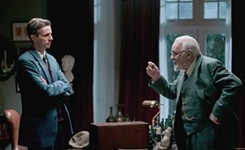
The Last Samurai
2003, R, 154 min. Directed by Edward Zwick. Starring Tom Cruise, Ken Watanabe, Timothy Spall, Hiroyuki Sanada, Tony Goldwyn, Billy Connolly.
REVIEWED By Steve Davis, Fri., Dec. 5, 2003
The Last Samurai is Hollywood’s reimagination of those gloriously muscular films by the great Japanese filmmaker Akira Kurosawa, cinematic masterpieces like Yojimbo and The Seven Samurai. From all appearances, the film – essentially a Western set in 19th-century Japan during the Meiji period – strives mightily to be a player in the genre. Not surprisingly, The Last Samurai largely falls short of its grand aspiration, compromised by Western filmmaking conventions in which the hero never dies and always gets the girl in the end. Whether the casting of Cruise in the film’s principal role, an embittered Civil War veteran who finds redemption in the honor code of the Japanese samurai warrior, dictated the need to follow those conventions is debatable. What is not debatable, however, is that Cruise is an actor of limited emotional resources, one who lacks the presence required for the film’s protagonist, a character intended to inhabit more than one dimension. The fact that Cruise performed his own stunts and swordplay is impressive, but those technical achievements only go so far. The character of Capt. Nathan Algren starts off as a dissolute drunk haunted by nightmares of bloodshed and carnage, and ends up the adopted son of a rebellious samurai outfit facing extinction by the encroaching influence of Western civilization and warfare. Whether he’s a pathetic alcoholic or a loyal brother-in-arms, however, Cruise doesn’t measure up. (To paraphrase the smidgen of Eastern philosophy imparted in this film, he is not one with the character.) Cruise’s shortcomings aren’t just a matter of his physical stature. He simply doesn’t fill the screen with the full-bodied complexity of some of his contemporaries, Russell Crowe primarily coming to mind. Indeed, Cruise pales next to Japanese actor Watanabe in the role of the stoic samurai leader Katsumoto, a warrior of infinite grace and power who sadly senses that the samurai’s days are numbered. (But for those Hollywood film conventions, Katsumoto is really the "last samurai" in this movie.) The basic premise in The Last Samurai – a white American army officer captured by an indigenous people is assimilated into their culture and takes arms against his former comrades – has the ring of familiarity, though Dances With Wolves (for all its faults) had a sense of epic romanticism, wrongheaded as it might be at times. Director Zwick expertly stages some of the most spectacular battle sequences since Kurosawa’s Ran, but they don’t compensate for the script’s more formulaic set-pieces or an eye-rolling ending that only serves to elevate Cruise’s character on an even higher pedestal. The true saving grace of The Last Samurai is its production values, which are historically impeccable and beautifully simplistic. Production designer Lilly Kilvert’s re-creation of the congested streets of Tokyo is in stark contrast to the pastoral eloquence of a rural samurai village, but both convey a time and place that don’t feel manufactured. Ngila Dickson’s costumes likewise splendidly evoke the Meiji era without attracting undue attention. And John Toll’s cinematography – clearly a frontrunner for the Oscar – is exquisitely true to its Japanese setting. The first appearance of the samurai rebels in a sun-dappled forest in early morning, ghostly apparitions charging on horseback, is absolutely breathtaking, something out of a beautiful and disturbing dream. While The Last Samurai empathizes with these outcasts proudly clinging to notions of honor and loyalty as a way of life, it is nevertheless a way of life in which violence plays an integral part. The film laughably draws good guy-bad guy distinctions with the objective of mythologizing the samurai, but in the end, those distinctions don’t mean much. The final showdown between these outnumbered rebel warriors, still embracing the tradition of hand-to-hand battle, and the conscripted Imperial Army, newly armed with guns and bullets, is a brutal and savage scene that underscores the undeniable conclusion that killing is killing, no matter how it is accomplished.
A note to readers: Bold and uncensored, The Austin Chronicle has been Austin’s independent news source for over 40 years, expressing the community’s political and environmental concerns and supporting its active cultural scene. Now more than ever, we need your support to continue supplying Austin with independent, free press. If real news is important to you, please consider making a donation of $5, $10 or whatever you can afford, to help keep our journalism on stands.
Richard Whittaker, May 17, 2019
Steve Davis, May 17, 2019
Kimberley Jones, Oct. 21, 2016
Jan. 19, 2024
The Last Samurai, Edward Zwick, Tom Cruise, Ken Watanabe, Timothy Spall, Hiroyuki Sanada, Tony Goldwyn, Billy Connolly










